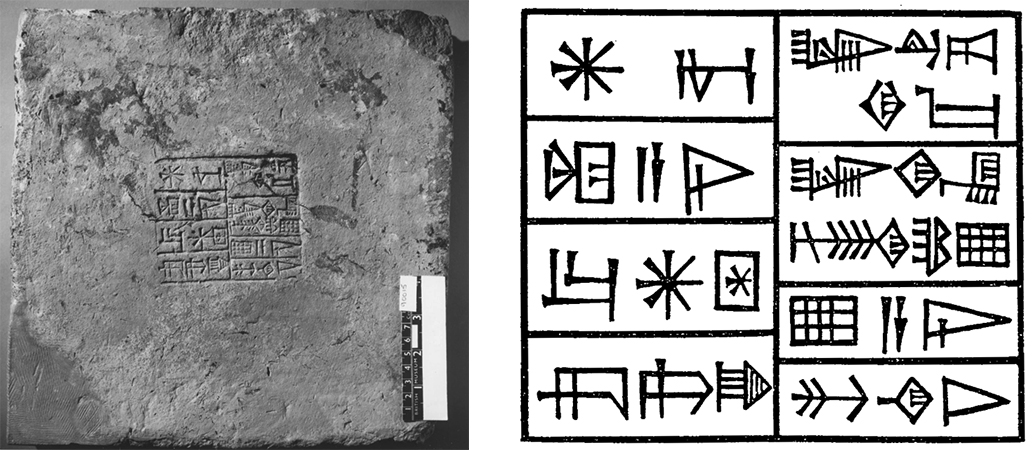29 Sumerian

This inscription is divided into two columns. The left-hand column is read first. Each column is divided into lines, each of which includes a noun phrase or a verb phrase. The individual cuneiform signs are read from left to right.
| Col. I. | 1 | Inanna | For Inanna, |
| 2 | ninani | his lady— | |
| 3 | UrNammu | Ur-Nammu, | |
| 4 | nitah kalaga | the mighty man, | |
| Col. II. | 5 | lugal Urima | the king of Ur, |
| 6 | lugal Kiengi Kiurike | the king of Sumer and Akkad— | |
| 7 | eani | her temple— | |
| 8 | munandu | built. |
Sumerian also has the honor of being a “language isolate.” It has no obvious relatives, living or dead. It must have had relatives in the past, but these have all died out, without any of them being recorded. Sumerian is regularly taught at Cal. As might be expected, it is primarily studied by those interested in the history and culture of Mesopotamia. But it is also of interest to general linguists, for whom it offers a number of interesting features.Sumerian was spoken in the most southern part of ancient Mesopotamia. With its oldest texts dating to no later than 3000 BCE, it has the distinction of being the first attested language known to us. After its death as a spoken language, about 2000 BCE, it continued to be studied in the Mesopotamian school system for another thousand years. Sumerian literature is the oldest preserved literature in the world, and some of its compositions still have the power to move us today.
Most Sumerian texts were written on clay “tablets” created when a scribe would go to the river, gather some clay, form it into a convenient shape, take a reed to use as a stylus, and inscribe right onto the clay. These tablets were then put out into the sun to dry. Important tablets, ones that scribes needed to keep for whatever reason, were baked in ovens.
The writing system for Sumerian is called “cuneiform,” because of the wedge-shaped form of the characters. It was probably invented by the Sumerians. It is a complicated system, with hundreds of signs, some representing syllables, others representing words. The cuneiform writing system was eventually adopted for languages unrelated to Sumerian, including Akkadian (a Semitic language) and Old Persian (Indo-European).
The vast majority of Sumerian texts are administrative and accounting records. The text reproduced here is a “royal inscription.” These are relatively short texts in which a ruler broadcasts his accomplishments, often the building of a temple. This particular one was inscribed on a mud-brick. These bricks formed part of the structure of a temple or palace. They would not have been visible to on-lookers: their function was to proclaim a ruler’s accomplishments to the gods, not to contemporary mortals. In many cases, the same text was recorded on dozens of bricks. This particular brick was commissioned by one Ur-Nammu, who ruled in the city of Ur from 2112 to 2095 BCE. It records the dedication of a temple in Ur to Inanna, the most important goddess in the Sumerian pantheon. Some dozen bricks with this same inscription have been preserved.
The first brick found bearing this inscription was uncovered in an excavation at the city of Uruk, in the 1850s. Now held in the British Museum, it was “published” in 1861 by Sir Henry Rawlinson, the most important figure in the decipherment of cuneiform writing. His edition appeared in the first volume of an important series entitled The Cuneiform Inscriptions of Western Asia, published by the British Museum.1 The brick reproduced here is also from Uruk. It was published in 1905, as part of a long series of volumes called Cuneiform Texts from the British Museum.2
Because it is expensive to publish photographs, most cuneiform texts have traditionally been published in “autograph” form. This means a copy hand-drawn by a modern-day scholar. The editions of texts published in Cuneiform Inscriptions and in Cuneiform Texts are all in autograph. A photograph of this particular exemplar first appeared in 1910. The analog photograph given here was created by the British Museum in 1990. Eventually, the British Museum will make available high-quality photographs of all their holdings online. But given that their holdings include many many thousands of cuneiform texts, this will take a while.
Hundreds of thousands of texts in Sumerian have survived. Many were unearthed by professional archaeologists; some were found accidentally; many others were illicitly excavated or stolen. They are scattered throughout the museums of the world. In order to keep track of them, the Cuneiform Digital Library Initiative led by Robert Englund at UCLA is an attempt to organize an online catalogue of all these texts, assigning every cuneiform text known a unique number.3
Contribution by John L. Hayes,
Lecturer, Department of Near Eastern Studies
Sources consulted:
- Rawlinson, Henry, Edwin Norris, George Smith, and Theophilus G. Pinches. The Cuneiform Inscriptions of Western Asia. London: Lithographed by R.E. Bowler, 1861. vols. 1-5
- British Museum. Department of Western Asiatic Antiquities. Cuneiform Texts from Babylonian Tablets in the British Museum. London: Published by the Trustees of the British Museum, 1959. vols. 1-58
- Cuneiform Digital Library Initiative (CDLI)
Author: unknown, autograph by Sir Henry Rawlinson
Imprint: Uruk (mod. Warka), Ur III (ca. 2100-2000 BCE)
Language: Sumerian
Language Family: Language isolate
Source: Cuneiform Digital Library Initiative (British Museum)
URL: https://cdli.ucla.edu (search by CDLI no.)

